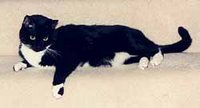
Many cats have color on their backs and heads but have white paws and a white belly. However, you almost never have a cat that is white everywhere but colored in the paws and belly. What's going on?
The answer can be found in the piebald spotting gene, abbreviated "S." During early kitten development, all of the pigment producing cells (melanocytes) are located close to the animal's spine. During development, those cells migrate from the spine area down toward the cat's sides, belly, legs, and paws. That process is controlled by the "S" gene.
Some lucky cats have two "good" copies of the S gene--SS. In those lucky cats, the pigment cell migration process works perfectly. The cells get all the way to the cat's feet. Lucy is an example:

Other cats have two "bad" copies of the S gene--ss. These cats still have pigment cells, but those cells don't migrate very far. So you get a cat that is more than 50% white, like this one:

Other cats have one "good" copy and one "bad" copy--Ss. In these cats, the pigment cells can get pretty far, but not all the way. That's how you end up with the very cute tuxedo cat:

The piebald gene illustrates something interesting about genetics: the phenomenon of incomplete dominance. Usually, if you have two alleles, one of them will be dominant. Suppose we're talking about human eye color. "B" is associated with brown eyes, and "b" is associated with blue eyes. Since B is dominant to b, an individual with one copy of each (Bb) will have brown eyes.
In piebald, however, there is really no dominant allele: SS, Ss, and ss all look totally different. We call that "incomplete dominance."
1 comment:
If I'm reading this right, my cat is ideal. :)
Post a Comment